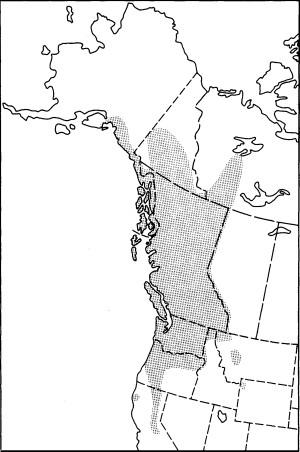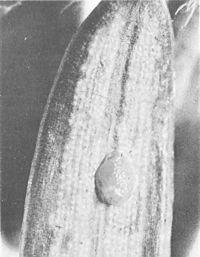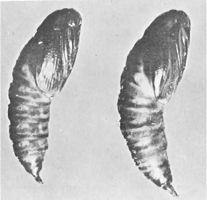Black-Headed Budworm in Western United States
***For the best information on current outbreak status and color photos, visit the USFS Alaska Region Western Blackheaded Budworm Website***
FOREST PEST LEAFLET 45
Donald C. Schmiege1 and David Crosby2
The black-headed budworm (Acleris gloverana Walsingham) is a native insect of western North America. Until recently this insect was considered one species, Acleris variana (Fernald). Taxonomic studies show that two species are probably involved: a western species, A. gloverana, and an eastern species, A. variana. The range of A. gloverana is from northern California and areas in the Rocky Mountain northward into Yukon and Northwest Territories in Canada and southeastern Alaska (fig. 1). The eastern portion of the range of A. gloverana may overlap the western portion of the range of A. variana, which extends to the Atlantic seaboard.
When conditions favor a high population of the black-headed budworm, the larvae cause extensive defoliation of hemlock spruce, and several species of fir trees of all ages may be killed, top-killed, or severely weakened Widespread outbreaks, sometime covering millions of acres, have occurred periodically in the Pacific Northwest, British Columbia and coastal Alaska. Defoliation by the budworm has often been accompanied or followed by high populations of other defoliators such as the hemlock sawfly and the spruce budworm.
Host Trees
The preferred host tree is western hemlock, but several other conifers are also attacked. If western hemlock stands are nearby, Sitka spruce may be seriously defoliated. Other hosts are Douglas-fir, Engelmann spruce, mountain hemlock, and true firs.
Evidence of Infestation
Black-headed budworms are wasteful feeders in that they do not usually consume entire needles. Some needles are clipped off near the base but remain in loose webbing spun by the budworro larvae. The dead, partially consumed needles turn red, causing heavily defoliated trees to have a scorched appearance. Budworm populations often increase so rapidly that forests that are green and healthy one year may appear red the next. Defoliation becomes noticeable from late June to late July, depending on latitude.
New foliage is preferred by young larvae, but mature larvae can utilize old foliage. High populations of the insect may cause complete defoliation, and death of treetops and of whole trees often follows if the outbreak continues for 2 or more years. Budworm populations usually build up for 2 or 3 years, remain at a high level for 2 or 3 years, and then decrease, often abruptly.

Description
The wing pattern and color of black-headed budworm moths are variable. The moths are usually mottled gray with brown, gray, or white bands across the wings. Some have a yellow, orange, or white stripe down each wing (fig. 2). The moth has a wingspread of about 3/4 inch. The eggs are yellow, about 1/32 inch long, oval, and flattened (fig. 3). A young larva is pale yellow green and has a black head; but as it grows the body becomes green, and between the fourth and fifth instars the color of the head changes to brown. A mature larva is about 1/2 inch long (fig. 4). The pupa is brown with a greenish tinge and appears leathery (fig. 5).
Life Cycle
The winter is spent in the egg stage. In late May or early June the larvae emerge from the eggs and either mine needles or bore into buds, where they usually remain until after the second molt. The mined buds are destroyed, one larva often boring into two or more buds. During the third larval stage, the larva leaves the expanding buds and constructs a loose shelter by clipping needles and fastening them with webbing. The larva then moves out from the shelter and feeds on new foliage. The larvae can feed on old foliage if all new foliage has been consumed. They pupate in or near their webbed shelters from mid-July to mid-August, depending on latitude.
The pupal period lasts from 10 days to 2 weeks after which the moths emerge from the pupal cases, mate, lay eggs, and die. Moths may live up to a month or more and can lay as many as 150 eggs, but the average is about 80. Eggs are deposited singly, usually on the underside of hemlock needles. The tops of the trees are preferred; but during an outbreak, eggs may be laid throughout the crown.

Natural Control
Black-headed budworm populations are normally held to low levels by several natural factors: diseases, parasites, and adverse weather. When conditions favor the budworm, however, the combined effects of the natural controls cannot prevent an outbreak. When high populations persist for 2 or more years, foliage may become depleted, causing larvae to starve. Starvation may be an important factor in population declines, both directly and, by reducing fecundity, indirectly.


More than 70 species of parasites have been recovered from the black-headed budworm in western North America. Occasionally, high budworm populations collapse as the result of a viral disease. Fungus diseases have also infected budworms. Climatic conditions may be important in preventing or controlling high budworm populations. Ice and snow sliding off foliage remove up to one-third of the overwintering eggs in Alaska. Unusually warm weather during early larval stages may kill the budworms directly or prevent them from feeding. Heavy rains during the late portion of the larval feeding period and stormy weather during the adult stage have greatly reduced populations in some Pacific coast areas.

References
TAXONOMIC STUDIES OF THE ACLERIS GLOVERANA-VARIANA COMPLEX, THE BLACK-HEADED BUDWORMS (LEPIDOPTERA: TORTRICIDAE). J. A. POWELL. Canad. Entomol. 94: 833-840. 1962.
THE FECUNDITY OF THE BLACK-HEADED BUDWORM ACLERIS VARIANA (FERN.) (LEPIDOPTERA : TORTRICIDAE) IN CPASTAL ALASKA. DONALD C. SCHMIEGE. Canad. Entomol. 97: 1226-1230. 1965.
THE RELATION OF WEATHER TO TWO POPULATION DECLINES OF THE BLACK- HEADED BUDWORM. DONALD C. SCHMIEGE. Canad. Entomol. 98: 1045. 1966.
A FURTHER NOTE ON THE RELATION OF WEATHER TO POPULATION TRENDS OF THE BLACKHEADED BUDWORM, ACLERIS V ARIAN A (FERN.) (LEPIDOPTERA: TORTRICIDAE) .G. T. SILVER. Canad. Entomol. 95: 58-61. 1963.

